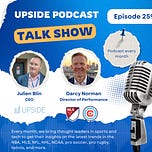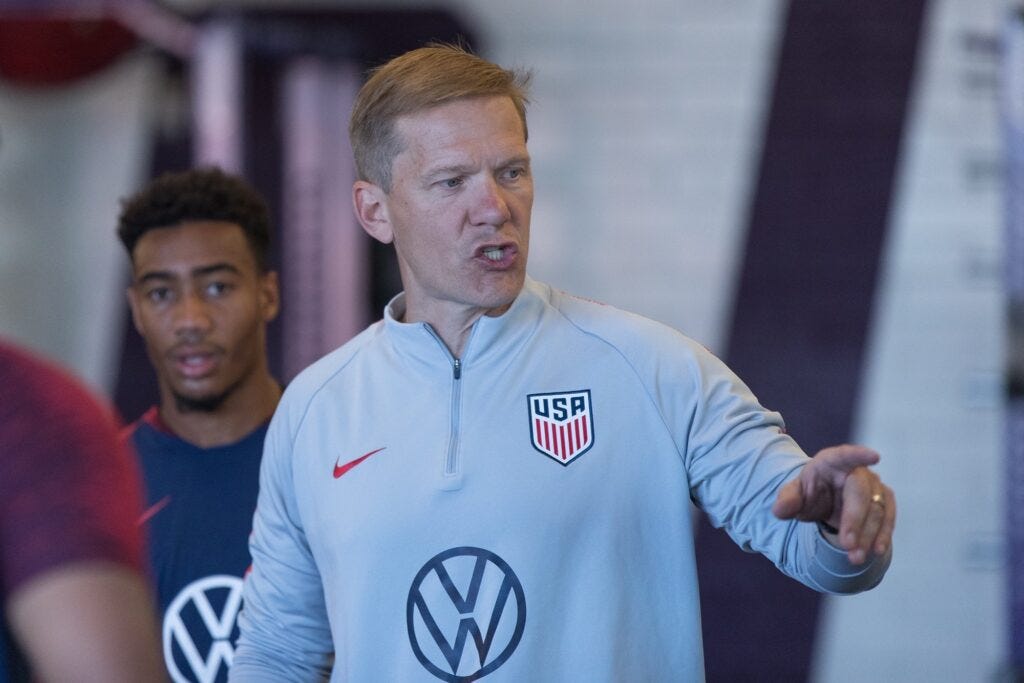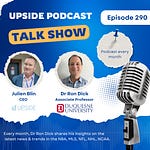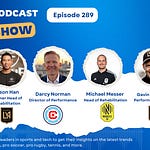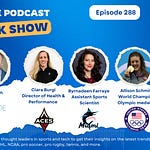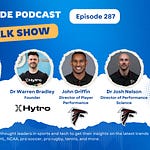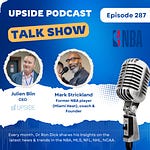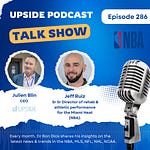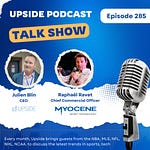Today we have the honor of interviewing Darcy Norman, the director of performance for the Chicago Fire FC a top MLS team.
Darcy Norman is the Director of Performance at Chicago Fire FC, where he oversees medical services, physical performance, nutrition, and sports psychology across the first team, Fire II, and the academy. With nearly 30 years in sports science and elite performance, Norman has worked at the highest levels—including the U.S. Men’s National Team (2019–2024), the German National Team during their 2014 World Cup win, AS Roma, and Bayern Munich. A licensed physical therapist and strength & conditioning specialist, he brings a data-driven and evidence-based approach developed through roles at Kitman Labs, EXOS, and international athletics, consistently building performance systems rooted in clear purpose, interdisciplinary trust, and athlete-first planning.
You can watch the video interview below by clicking on the Youtube link. You can also listen to the audio interview by clicking on the link at the top of the page:
📝Show Notes: Through this interview, we touched on:
His journey & influences
His goal-driven technology adoption approach
His multi-directional training philosophy
Innovation vs. fundamentals
Similarities and differences between working for European Vs US teams
The future of performance in MLS
On the most impressive players he worked with
His personal reflection on success
You can read the full transcript of the podcast interview with Darcy located at the top of this blog post.
Here are the quotes from the interview with Darcy:
Q1. Your Journey & Influences
"I’ve worked with two national teams—the German and the U.S.—and three clubs: Bayern Munich fc, AS Roma, and now Chicago Fire FC. What I’ve learned over 20 years is that everything starts with trust and transparency. Whether it's a coach-to-therapist, player-to-practitioner, or practitioner-to-practitioner relationship, it’s all about putting the athlete first. The athlete is there to perform—for their club or their country—and our role is to support them holistically. That means thinking about what information the other side needs when an athlete transitions between environments. It’s about being communicative, passing on testing data, wellness info, GPS metrics—everything—so the athlete doesn’t miss a beat. And critically, putting yourself in the shoes of your counterparts helps build a truly athlete-first performance model."
"There’s no one right way to do this work. There are best practices, yes, but you have to stay flexible because every team, coach, and culture is different. It’s about understanding that context and adapting while keeping your standards high."
Q2. Goal-Driven Technology Adoption
"It starts with purpose—understanding exactly what you're trying to accomplish. That clarity drives everything. Then, you map out your planning, periodization, and education strategy. Technology doesn’t come first. You first define the questions you're trying to answer or the behaviors you're trying to reinforce. Then you ask: will this tool actually help me solve this specific problem or improve our process? If it does, it’s worth considering. If not, it’s noise."
"You’ve also got to evaluate the tech practically—does it fit into your workflow, or does it disrupt it? Is it intuitive to use, or do you need extra staff just to operate it? Can it integrate with your other systems? Can you collect the data often enough to run applied research and actually improve your process over time? And perhaps most importantly: does the company have your interests in mind, or are they just chasing investment returns?"
"At the end of the day, the dream is this: I have a question, I push a button, and I get a meaningful answer. That’s when technology is really working for you."
Q3. Multi-Directional Training Philosophy
"We look at movement from a foundational level. First, can the athlete even get into the right shapes? Do they have the range of motion to access basic skill positions—whether that’s for acceleration, deceleration, or change of direction? Then we look at functional movement patterns—squats, lunges, single-leg balance—and ask: can they do these well? Then we evaluate capacity: strength, strength endurance, power, power endurance, relative strength. All of this leads up to how well they express these qualities in linear or multi-directional movement—the very things that define soccer."
"Soccer is inherently multi-directional, yet some players can’t drop their hips or create strong base positions when changing direction. That affects performance and injury risk. So we break it down and figure out what’s limiting them—then individualize their programming to fix it. You can absolutely improve how someone moves. It’s not just talent. It’s a skill you can coach and train."
"We use external cueing and constraints-based drills to help players self-organize better mechanics. When you design drills that demand a certain body shape or action—like cutting around a tilted pole—they naturally adopt better mechanics without needing constant verbal cues. That’s how you create real, lasting change in movement quality."
Q4. Innovation vs. Fundamentals
"I’ve been in this space for 30 years. When I started, all we had were a stopwatch, a tape measure, and a clipboard. So you had to rely on your planning, your programming, and your coaching ability. And those fundamentals—how you progress, how you periodize, how you educate—still matter more than anything else."
"Now we have all this data, but if you don’t have a solid framework to interpret and apply it, it’s useless. What I see sometimes is young practitioners jumping into tech first, without a foundation. You’ve got to reverse that. Start with your purpose. Then build the methods and select tools that enhance what you’re already doing. Technology should serve the plan—not the other way around."
Q5. On Similarities and Differences between working for European Vs US teams
"It’s really not that different. It comes down to coaching philosophies and club philosophies. Do they have a really clear purpose in how they’re trying to do things? What’s their standard? Are they applying best practices and science—and how well are they communicating and integrating that into their day-to-day?"
"In North America now, definitely the resources are getting better and better. At Chicago Fire, I would say we’re applying best practices across the board—from recovery to training, periodization, technology, and science."
Q6. It’s Not Europe vs. U.S.—It’s Standards vs. Gaps
"I’ve seen clubs in both North America and Europe that apply phenomenal best practices. And I’ve seen clubs in both places that don’t. It really depends on the organization’s clarity of purpose and their commitment to operating at a high level."
Q7. On the Future of Performance in MLS
"Staff development is a huge area of opportunity. Just like on the field, your performance and medical staff need to be a high-functioning team. You’ve got experts from all over—different countries, different training—so the question is: how do you get them all on the same page and working toward a common goal? That’s leadership. That’s culture."
"The other massive area is data integration. The teams that invest in building robust data systems—where everything is connected and contextualized—will be the ones who make faster, more accurate decisions. They’ll be able to refine their systems quickly and outpace the competition. You’ll see the gap grow between teams that understand this and those that don’t. Data alone isn’t the answer—but when structured properly, it becomes a powerful decision-making tool."
Q8. On the Best Coaches He has worked with
"The best coaches I’ve worked with have a really clear purpose, a really clear vision, and a really clear way. They know what they’re trying to accomplish, how they want to do it, and they’re relentless in their ability to execute that."
"It’s not just about the technical and tactical side. The best coaches are also great communicators, great planners, and great people managers”.
Q9. On the Most Impressive Players He Worked with
"The best athletes I’ve worked with are humble. They’re always trying to get better, even if they’re the best in the world. They don’t let their current state define them—they just keep pushing and pushing to understand what’s possible."
"That’s why you see records being broken. That’s why you see players performing at high levels into their late 30s. Guys like Ronaldo or Messi are still operating close to 40 because they’re consistent and focused on making the right choices day after day."
Q10. On Longevity & Support Systems
"I was just at a conference talking about centenarian athletes—guys who’ve played over 60,000 elite-level minutes. What allows them to do that? Clean schedules, consistency, good support teams around them, and removing stress so they can focus on the main thing."
Q11. On His Personal Reflection on Success
"People have complimented me on my success in my career… I don’t think I did anything extraordinary. But what I did do well was know which bus to get on. I always asked myself: do my values match the values of the people I want to work with?"
You may also like:

